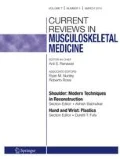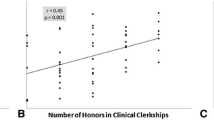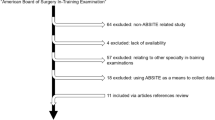Abstract
Orthopedic surgery residency training is a difficult endeavor, and the selection of residents that will perform well in a rigorous training program is challenging for residency program directors. Even defining a “great” resident is a difficult endeavor. However, there are certain qualities that anecdotally are associated with high-performing residents, which include being trustworthy, hard-working and efficient, self-directed learners, detail-oriented, and personable. These qualities are difficult to teach and are likely learned by an individual during their early years of education and groomed during college and medical school. Individuals possessing these characteristics are more likely to bring a high-level of professionalism to their work as residents and to perform well on objective measures of success in residency such as high OITE scores, good faculty evaluations, and peer-reviewed publications. We discuss the available, but limited, literature on what makes a “great” resident and share the resident perspective on this topic.
Similar content being viewed by others
References
Papers of particular interest, published recently, have been highlighted as: • Of importance
Kennedy TJ, Regehr G, Baker GR, et al. Preserving professional credibility: grounded theory study of medical trainees’ requests for clinical support. BMJ. 2009;338:b128. doi:10.1136/bmj.b128.
Sterkenburg A, Barach P, Kalkman C, et al. When do supervising physicians decide to entrust residents with unsupervised tasks? Acad Med. 2010;85:1408–17. doi:10.1097/ACM.0b013e3181eab0ec.
Breen KJ, Hogan AM, Mealy K. The detrimental impact of the implementation of the European working time directive (EWTD) on surgical senior house officer (SHO) operative experience. Ir J Med Sci. 2013;182:383–7. doi:10.1007/s11845-012-0894-6.
Canter R. Impact of reduced working time on surgical training in the United Kingdom and Ireland. J R Coll Surg Edinb. 2011;9 Suppl 1:S6–7. doi:10.1016/j.surge.2010.11.020.
Lim E, Tsui S. Impact of the European Working Time Directive on exposure to operative cardiac surgical training. Eur J Cardiothorac Surg. 2006;30:574–7. doi:10.1016/j.ejcts.2006.04.024.
Al-Hadithy N, Gikas PD, Al-Nammari SS. Smartphones in orthopaedics. Int Orthop. 2012;36:1543–7. doi:10.1007/s00264-012-1527-4.
Rowley BD, Baldwin DC Jr, Bay RC, et al. Can professional values be taught? A look at residency training. Clin Orthop Rel Res. 2000;378:110–4. doi:10.1097/00003086-200009000-00018.
Reed DA, West CP, Mueller PS, et al. Behaviors of highly professional resident physicians. JAMA. 2008;300:1326–33. doi:10.1001/jama.300.11.1326.
Ponce BA, Determann JR, Boohaker HA, et al. Social networking profiles and professionalism issues in residency applicants: an original study-cohort study. J Surg Educ. 2013;70:502–7. doi:10.1016/j.jsurg.2013.02.005.
Evarts CM. Resident selection: a key to the future of orthopaedics. Clin Orthop Related Res. 2006;449:39–43. doi:10.1097/01.blo.0000224032.23850.55.
Spitzer AB, Gage MJ, Looze CA, et al. Factors associated with successful performance in an orthopaedic surgery residency. J Bone Joint Surg. 2009;91:2750–5. doi:10.2106/JBJS.H.01243. This paper examined factors from both medical school and during residency that were associated with good performance in an orthopedic surgery training program.
Hurwitz SR. 2012 Rules and Procedures for Residency Education Part I and Part II Examinations. Chapel Hill: American Board of Orthopedic Surgery, Inc.; 2012.
Macknin JB, Brown A, Marcus RE. Does research participation make a difference in residency training? Clin Orthop Related Res. 2013. doi:10.1007/s11999-013-3233-y.
Atesok KI, Hurwitz SR, Egol KA, et al. Perspective: integrating research into surgical residency education: lessons learned from orthopaedic surgery. Acad Med. 2012;87:592–7. doi:10.1097/ACM.0b013e31824d2b57.
Ginsburg S, McIlroy J, Oulanova O, et al. Toward authentic clinical evaluation: pitfalls in the pursuit of competency. Acad Med. 2010;85:780–6. doi:10.1097/ACM.0b013e3181d73fb6.
Gofton W, Regehr G. What we don’t know we are teaching: unveiling the hidden curriculum. Clin Orthop Related Res. 2006;449:20–7. doi:10.1097/01.blo.0000224024.96034.b2.
Compliance with Ethics Guidelines
Conflict of Interest
Venu M. Nemani, Caroline Park, and Danyal H. Nawabi declare that they have no conflict of interest.
Human and Animal Rights and Informed Consent
This article does not contain any studies with human or animal subjects performed by any of the authors.
Author information
Authors and Affiliations
Corresponding author
Rights and permissions
About this article
Cite this article
Nemani, V.M., Park, C. & Nawabi, D.H. What makes a “great resident”: the resident perspective. Curr Rev Musculoskelet Med 7, 164–167 (2014). https://doi.org/10.1007/s12178-014-9210-6
Published:
Issue Date:
DOI: https://doi.org/10.1007/s12178-014-9210-6




